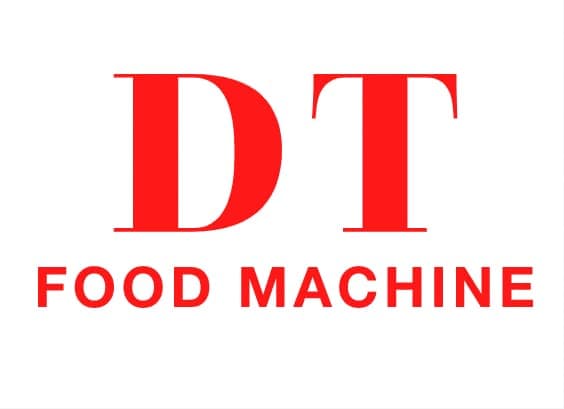Introduction
The global demand for frozen French fries continues to surge, driven by fast-food chains, restaurants, and supermarkets. Behind every crispy and golden fry is a sophisticated frozen French fries production line that ensures consistent quality, efficiency, and safety. If you’re in the food processing industry or considering entering the frozen snack segment, understanding the structure, workflow, and equipment of a frozen French fries production line is crucial.
In this comprehensive guide, we’ll explore the entire journey from raw potatoes to packaged frozen fries, provide technical specifications, and offer insights to help you optimize or set up a production line.
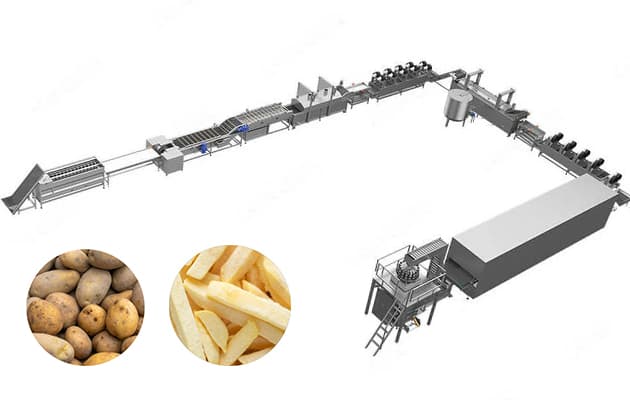
1. What is a Frozen French Fries Production Line?
A fully automatic frozen French fries production line is an automated system that transforms fresh potatoes into frozen, ready-to-fry French fries. It involves a sequence of processes such as washing, peeling, cutting, blanching, frying, freezing, and packaging.
This industrial solution ensures mass production with uniformity, hygiene, and compliance with international food standards.
2. Why Invest in a Frozen French Fries Production Line?
2.1 Rising Global Demand
According to industry reports, the global frozen potato market is projected to exceed USD 80 billion by 2030. French fries are a significant segment within this category.
2.2 Long Shelf Life
Frozen fries have a shelf life of up to 12 months, reducing food waste and improving logistics.
2.3 Efficient Scaling
Automated frozen French fries production lines allow manufacturers to scale operations rapidly while maintaining quality.
3. Key Components of a Frozen French Fries Production Line
3.1 Potato Receiving and Cleaning System
- Function: Removes dirt, sand, and stones.
- Machines involved: Elevators, washing tanks, rotary drum cleaners.
3.2 Peeling Machine
- Types: Abrasive peelers and steam peelers.
- Key Features: Adjustable peeling time, stainless steel body, waste reduction system.
3.3 French Fries Cutting Machine
- Function: Cuts potatoes into uniform sticks.
- Blade Options: 7mm, 10mm, and crinkle-cut variations.
3.4 Blanching Machine
- Purpose: Deactivates enzymes, removes sugars to prevent browning.
- Temperature Control: 80–90°C with adjustable timing.
3.5 De-watering System
- Types: Air knife or centrifugal systems.
- Function: Removes excess moisture before frying.
3.6 Continuous Frying Machine
- Temperature: 160–180°C.
- Oil Filtration: Automatic filtering system to prolong oil life.
3.7 De-oiling and Cooling Conveyor
- Purpose: Removes excess oil and cools fries before freezing.
3.8 IQF Freezing Tunnel
- Type: Individual Quick Freezing (IQF).
- Temperature: -35°C to -40°C.
3.9 Packaging Machine
- Automation Level: Fully automatic.
- Options: Nitrogen flushing for extended shelf life.
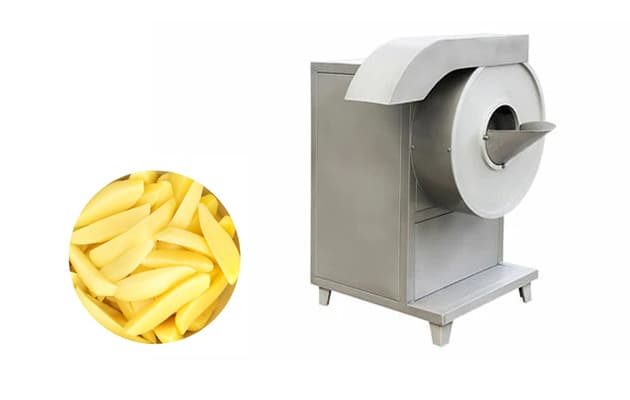
4. Workflow of Frozen French Fries Production Line
- Raw Potato Reception
- Washing & Sorting
- Peeling
- Cutting
- Blanching
- De-watering
- Frying
- De-oiling & Cooling
- Freezing
- Weighing and Packaging
5. Technical Parameters Table
| Equipment | Capacity (kg/h) | Power (kW) | Dimensions (mm) | Material |
|---|---|---|---|---|
| Washer | 1000–5000 | 3.0 | 2800×1200×1350 | SS304 |
| Peeler | 1000–4000 | 2.2 | 1600×900×950 | SS304 |
| Cutter | 500–2000 | 1.5 | 1000×800×1200 | SS304 |
| Blancher | 1000–3000 | 25.0 | 5000×1500×1800 | SS304 |
| Fryer | 1000–4000 | 80.0 | 7000×1600×2000 | SS304 |
| Freezer | 1000–5000 | 50.0 | 10000×3000×2500 | SS304 |
| Packer | 500–2000 | 3.5 | 2000×900×1500 | SS304 |
6. Capacity Configurations for Frozen French Fries Production Line
6.1 Small Scale (300–500 kg/h)
- Ideal for startups or local businesses.
- Lower capital investment.
- Manual assistance in sorting and packaging.
6.2 Medium Scale (1000–2000 kg/h)
- Suitable for regional distributors.
- Semi-automatic operation.
- Modular expansion possible.
6.3 Large Scale (5000+ kg/h)
- High-volume production.
- Fully automated with central control system.
- Integrated SCADA and ERP data collection.
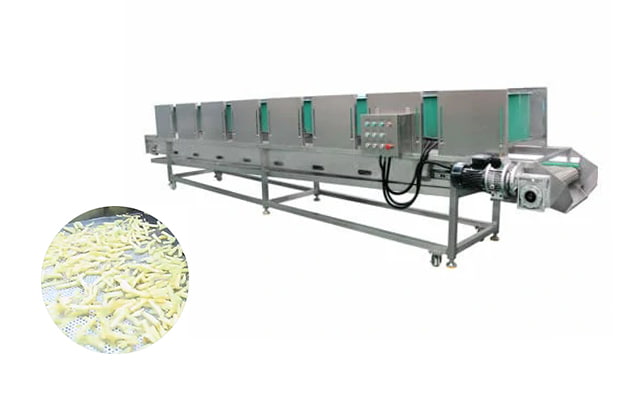
7. Cost Analysis of a Frozen French Fries Production Line
Understanding the investment required for a frozen French fries production line is critical for budgeting and long-term profitability. Costs vary based on production scale, level of automation, and equipment quality.
7.1 Equipment Costs by Capacity
| Capacity | Estimated Cost (USD) | Description |
|---|---|---|
| 300–500 kg/h | $50,000–$80,000 | Semi-automatic, basic functions |
| 1000–2000 kg/h | $150,000–$250,000 | Standard line with full pre-treatment and frying |
| 3000–5000+ kg/h | $400,000–$1,000,000+ | Fully automated with SCADA, energy recovery |
7.2 Operating Costs
- Labor: Depends on automation level. Automated systems reduce labor costs.
- Energy Consumption: Fryers and freezers are energy-intensive.
- Water & Steam: Blanching and peeling require large water volumes.
- Maintenance: Bearings, belts, filters, and pumps need regular servicing.
- Packaging: Costs depend on bag material and branding requirements.
7.3 Return on Investment (ROI)
A well-optimized frozen French fries production line can yield ROI within 1–2 years, especially when supplying to fast-food chains or export markets.
8. Quality Control and Food Safety Standards
Maintaining high product quality is essential to meet customer expectations and regulatory compliance.
8.1 Key Quality Control Measures
- Size Uniformity: Regular inspection of cutting blades.
- Oil Quality: Automatic filtration to prevent re-frying particles.
- Freezing Consistency: IQF tunnel ensures separation of fries.
- Moisture Control: Final product moisture content should be <5%.
8.2 Compliance with International Standards
- HACCP (Hazard Analysis and Critical Control Points)
- ISO 22000 / FSSC 22000
- FDA / USDA standards (for U.S. market)
- EU Food Safety Authority regulations
8.3 Clean-In-Place (CIP) Systems
Modern lines use CIP systems to automate cleaning of pipes, tanks, and conveyor belts, improving hygiene and reducing downtime.
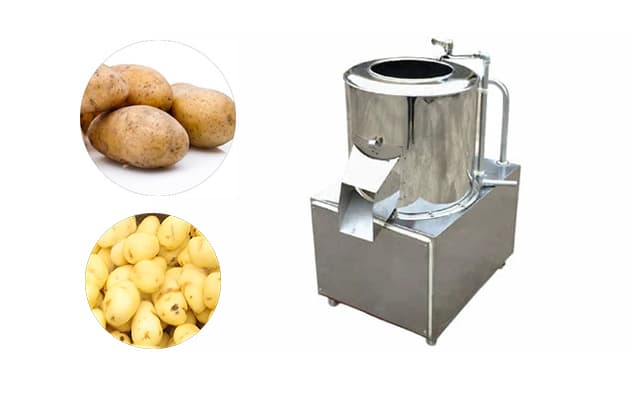
9. Applications and End Markets
The final frozen French fries product serves a wide array of industries:
9.1 Food Service
- Fast-food restaurants (McDonald’s, KFC)
- Diners and cafes
- Food delivery platforms
9.2 Retail Packaging
- Supermarkets (private label or brand-name)
- Convenience stores
- Online food retailers
9.3 Export Markets
Emerging markets in Africa, Southeast Asia, and the Middle East are rapidly increasing imports of frozen potato products.
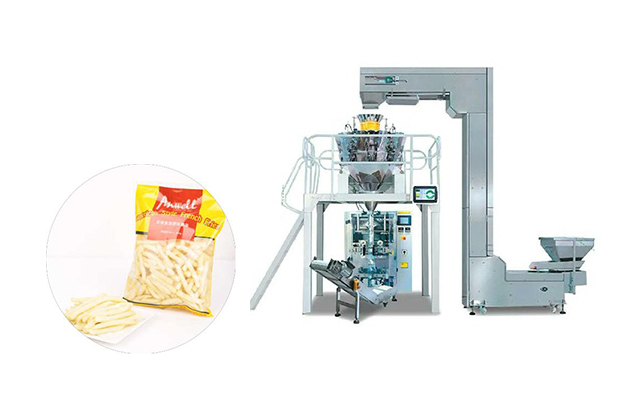
10. Case Studies and Real-Life Applications
10.1 Case Study: Small Scale in Nigeria
A startup in Lagos installed a 500 kg/h frozen French fries production line and became a regional supplier for quick-service restaurants (QSRs). ROI was achieved within 18 months.
10.2 Case Study: Industrial Scale in India
A multinational invested in a 5000 kg/h line to meet the demands of South Asian QSR chains. Integrated SCADA system provided real-time monitoring and energy-saving features.
10.3 Case Study: Export-Oriented in Egypt
This medium-scale plant focused on the EU and Gulf markets, with nitrogen-flushed packaging for shelf life extension, generating 30% growth in export revenue annually.
11. Common RFQs (Request for Quotation) and Buyer Questions
Here are the most frequent questions buyers ask when considering a frozen French fries production line:
Q1: What is the average lead time for manufacturing the line?
A: Standard lead times range from 45 to 90 days depending on customizations.
Q2: Can I produce other potato products with the same line?
A: Yes, the line can be adapted for hash browns, wedges, crinkle fries, and sweet potato fries with minimal modifications.
Q3: What about installation and training?
A: Most suppliers provide overseas installation, commissioning, and staff training.
Q4: Do you offer after-sales support and spare parts?
A: Reputable suppliers offer 12–24 months warranty, online diagnostics, and express spare part shipping.
Q5: How much space is required?
A: A standard 1000 kg/h line needs around 250–400 m². A 5000 kg/h line may require over 1000 m².
12. How to Choose a Reliable Manufacturer
12.1 Checklist for Evaluation
- CE / ISO Certifications
- Export Experience
- Factory Visit Availability
- Customizable Equipment Options
- Technical Support Team
12.2 Top Manufacturers of Frozen French Fries Production Line
| Company Name | Country | Website | Notable Feature |
|---|---|---|---|
| DT Food Machine Co., Ltd. | China | dtfoodmachine.com | Full turnkey solution provider |
| JBT Corporation | USA | jbtc.com | Global presence, advanced tech |
| Kiremko | Netherlands | kiremko.com | Specialized in large-capacity lines |
| Heat and Control | USA | heatandcontrol.com | Industry leader in frying systems |
13. Conclusion and Future Trends
The frozen French fries industry is booming, and setting up a frozen French fries production line is a strategic move for long-term business success. Innovations in AI-powered vision sorting, energy-efficient frying, and smart packaging are reshaping the future of potato processing.
13.1 Future Trends
Customization for Local Tastes: Spiced, coated, or seasoned fries.
Eco-friendly Packaging: Compostable or recyclable materials.
AI-driven Quality Control: Machine vision systems to detect defects.
Smart Plant Monitoring: IoT integration for predictive maintenance.
